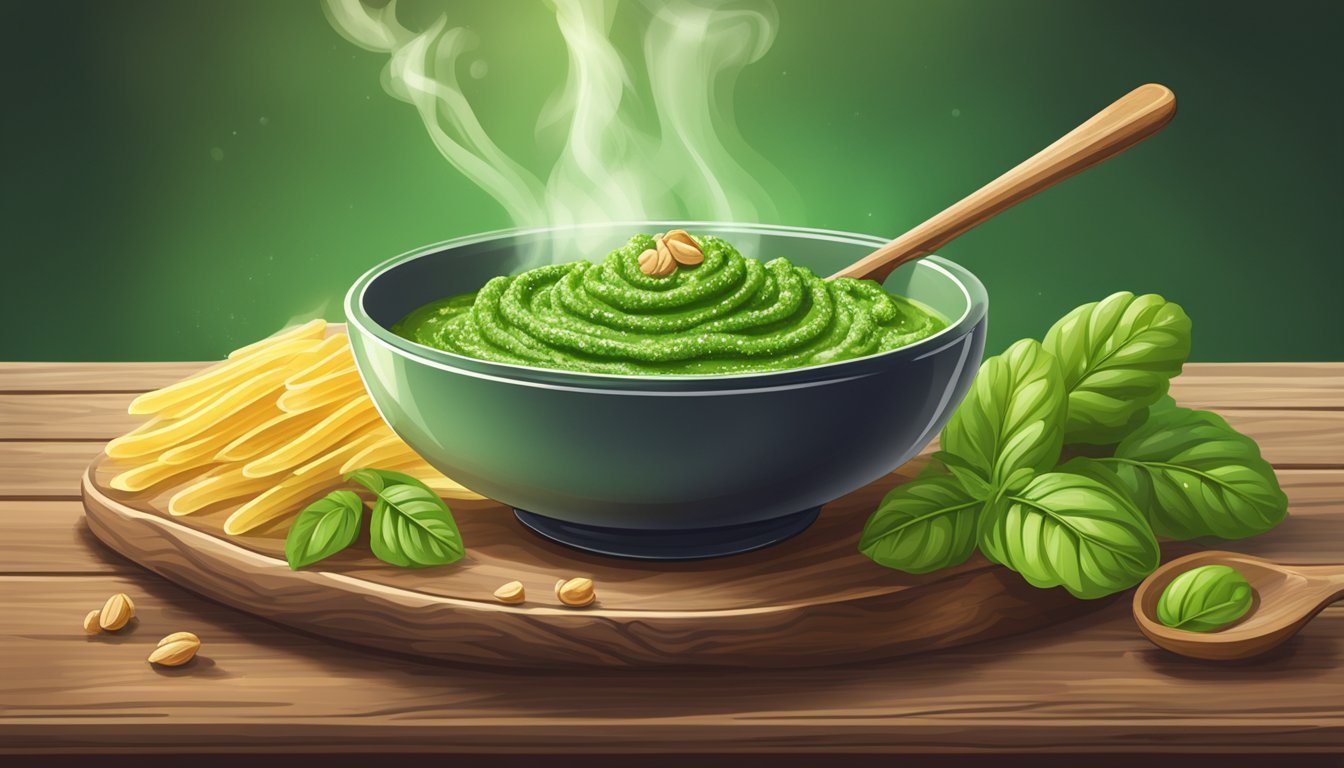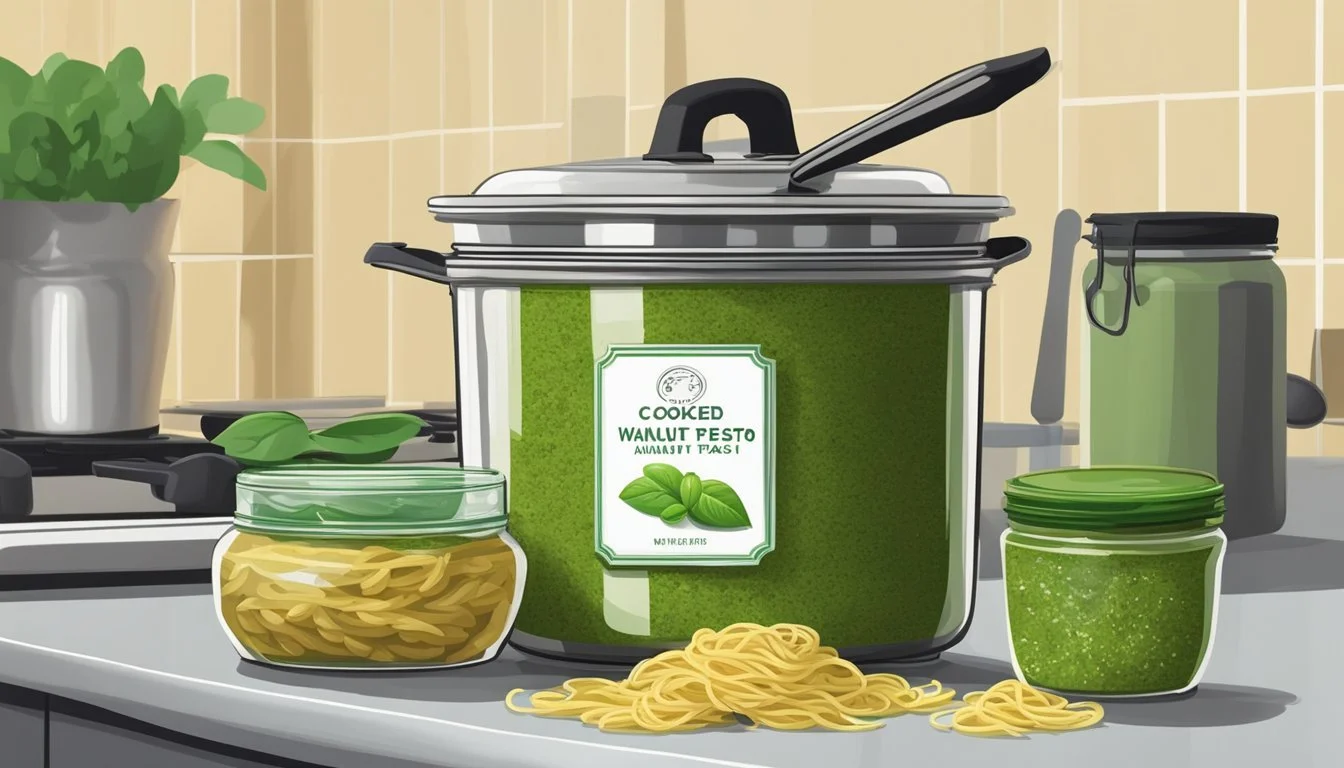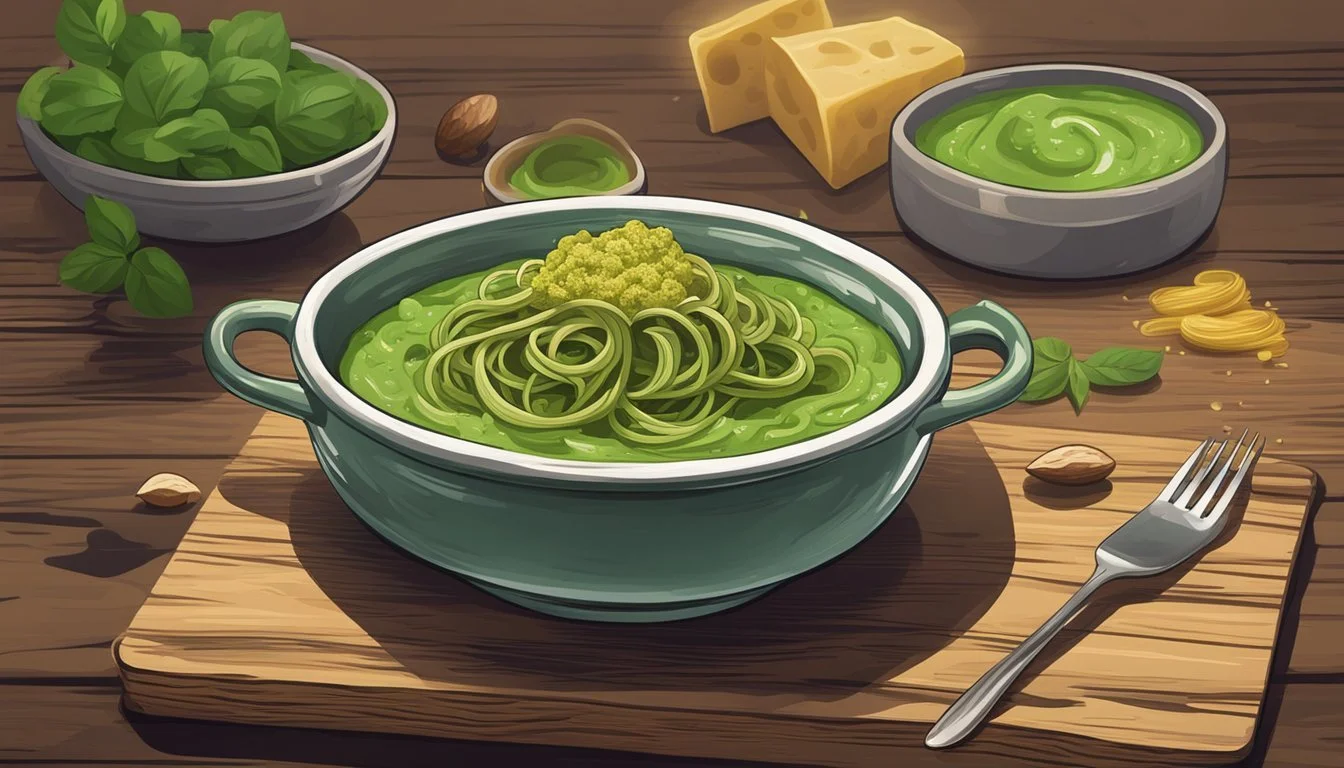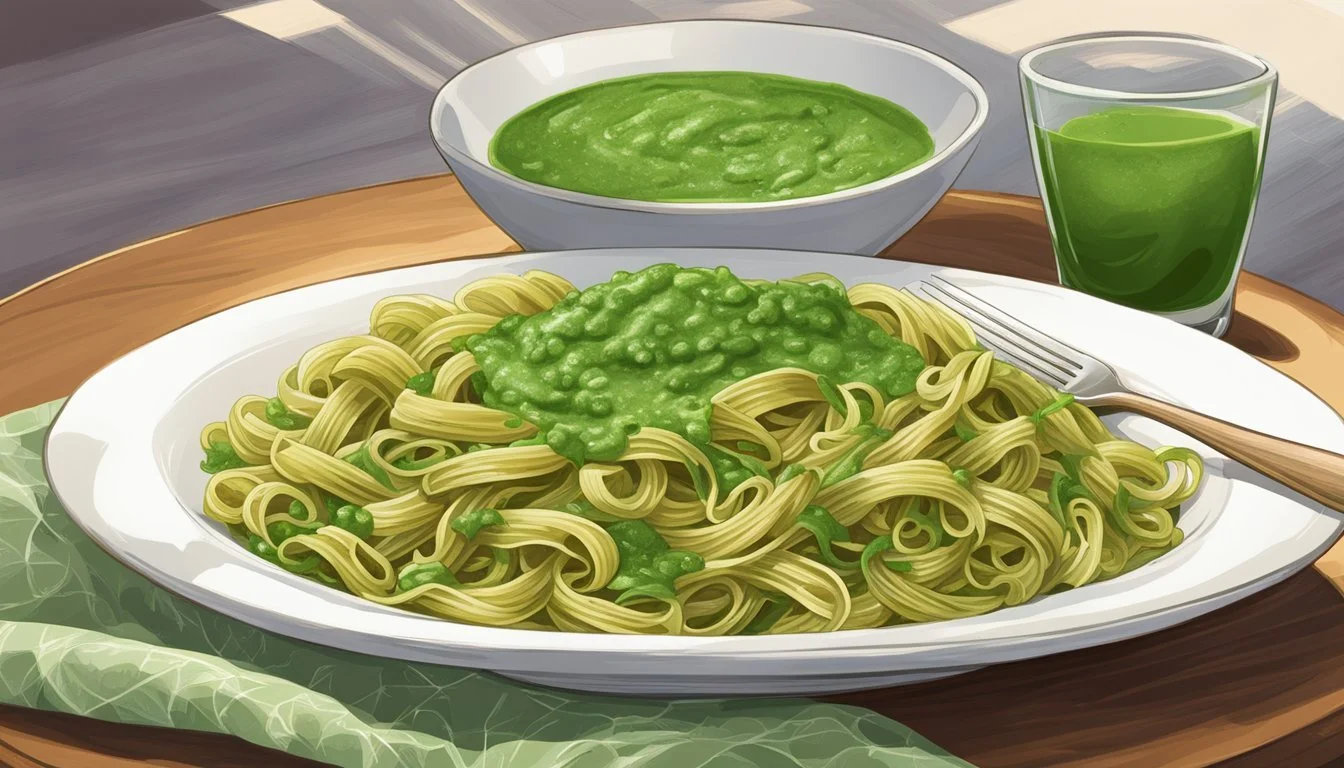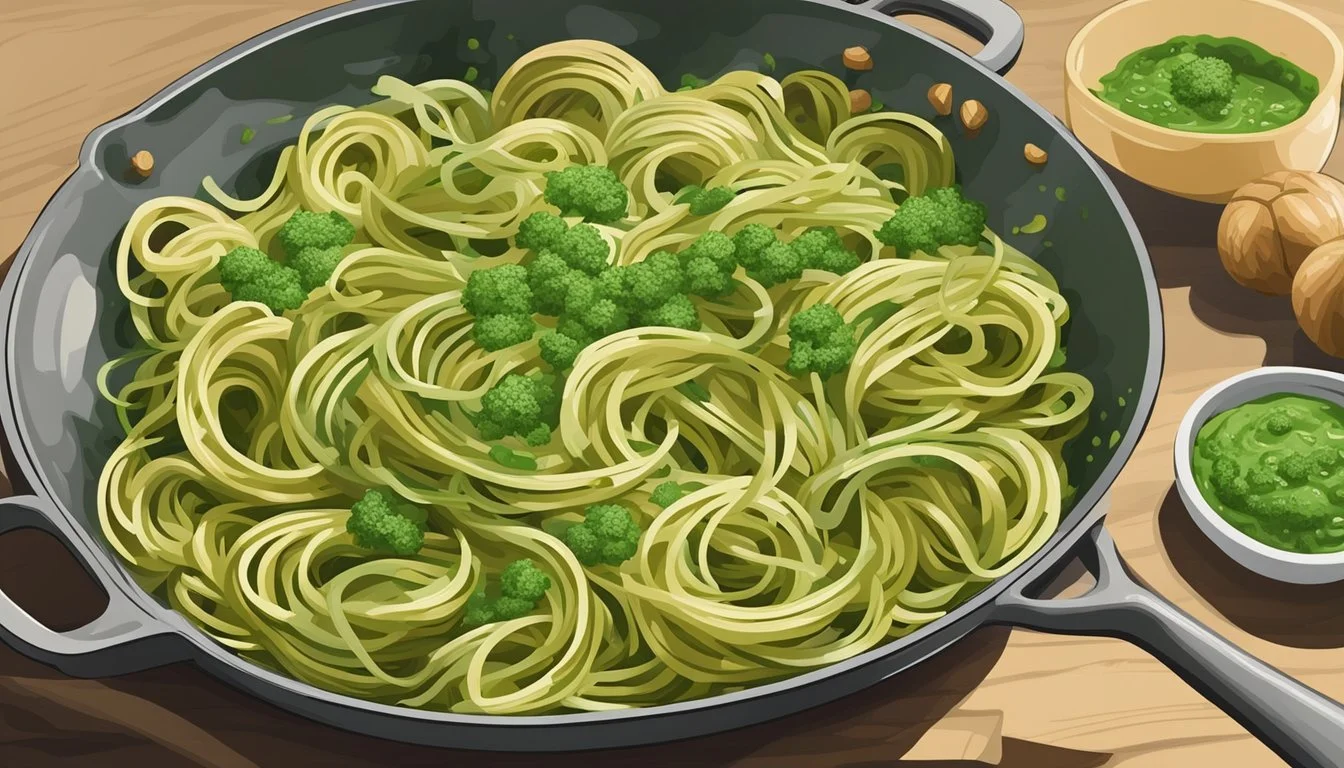Best Way to Reheat Walnut Pesto Pasta
Maintaining Sauce Vibrancy
Walnut pesto pasta (What wine goes well with pasta?), with its rich flavors and aromatic presence, is a dish worth savoring even on the second day. The key to enjoying leftover pesto pasta lies in the reheating process, which should revive the dish without compromising the delicate nature of the pesto sauce. When it comes to reheating, the primary goal is to maintain the vibrant color and texture of the walnut pesto sauce while ensuring the pasta is heated to the right temperature for a pleasurable eating experience.
The challenge with reheating pesto pasta is preserving the integrity of the sauce, which can easily become oily or change color if not handled correctly. Traditional pesto, made with basil, walnuts, garlic, Parmesan cheese, and olive oil, is particularly sensitive to heat. Therefore, care must be taken to gently warm the dish, activating the sauce's flavors without reaching a temperature that would cause the ingredients to separate or the herbs to oxidize. The reheating method chosen can make a significant difference in the outcome, and it is essential to select a technique that aligns with the unique properties of walnut pesto pasta.
Understanding Pesto Pasta
Pesto pasta combines the rich flavors of pesto sauce with the hearty texture of pasta for a truly delightful dish. This section will explore the key elements of pesto along with its nutritional aspects.
Origins and Components of Pesto
Pesto is a sauce that hails from Genoa, the capital city of Liguria, Italy. Its name is derived from the Genoese word "pestâ," which means to pound or crush, referring to the traditional way of preparing the sauce by crushing the ingredients.
Key Ingredients of Classic Pesto:
Basil (Ocimum basilicum): The principal herb, providing an aromatic freshness.
Olive Oil: Used for its smooth texture and as a preserving agent.
Parmesan Cheese (Parmigiano-Reggiano): Adds a salty and nutty flavor.
Pine Nuts: Traditional nut used for its buttery taste, with alternatives such as almonds sometimes used.
Garlic: Contributes a pungent kick to the sauce.
These ingredients are blended together to form a vibrant green sauce that embodies the flavors of the Mediterranean.
Nutritional Profile
The nutritional content of pesto can vary based on the specific ingredients, but a general profile for the primary components in pesto sauce is as follows:
Nutritional Information (per 100 grams of traditional pesto):
Calories: Approximately 400 kcal
Proteins: Around 3 grams
Carbohydrates: About 3 grams
Fats: Roughly 40 grams, with a significant proportion being monounsaturated fats from the olive oil
Iron: Olive oil and pine nuts contribute to the iron content
It is important to note that while pesto is calorically dense due to the olive oil and pine nuts, these ingredients provide healthy fats that are essential to a balanced diet. Basil adds a minimal caloric value but provides various vitamins and antioxidants. Parmesan cheese offers both protein and calcium, though it also increases the fat content.
When combined with pasta, the overall nutritional profile will include additional carbohydrates and proteins, making it a more energy-rich meal.
Preparation and Storage of Walnut Pesto Pasta
When preserving the quality and freshness of walnut pesto pasta, proper storage techniques are essential. It's crucial to protect the distinct flavors and textures for when the pasta is reheated.
Proper Storage Techniques
To ensure leftover walnut pesto pasta remains tasty, it should be stored correctly in the refrigerator. One should store the leftover pasta and pesto sauce separately to maintain the best quality. The pasta should be placed in an airtight container or sealed plastic bag, with a small drizzle of olive oil to prevent clumping. Leftover pesto should be transferred to an airtight container and covered with a thin layer of olive oil to prevent oxidation. This layer acts as a seal to keep the pasta sauce vibrant. The leftovers can last in the refrigerator for approximately 2-3 days.
Leftover Pasta: Airtight container, light coating of olive oil, refrigerate.
Pesto: Airtight container, cover with olive oil, refrigerate.
Freezing and Thawing Pestos
For longer storage, walnut pesto can be frozen. To freeze, one can portion the pesto into an ice cube tray, cover with plastic wrap, and freeze. Once frozen, the cubes should be transferred to a freezer bag or container to prevent freezer burn. This method makes it easy to thaw only what is needed for a future meal. To thaw, simply move the required amount of pesto cubes to the refrigerator overnight or let them sit at room temperature for a few hours before reheating.
Freezing Pesto:
Pour into an ice cube tray.
Cover and freeze.
Transfer to a freezer bag or container.
Thawing Pesto:
Refrigerate overnight.
Or, allow to sit at room temperature.
Using these techniques will ensure the walnut pesto pasta retains its desired taste and texture when ready to be enjoyed again.
Reheating Walnut Pesto Pasta
Reheating walnut pesto pasta carefully ensures that its vibrant sauce maintains flavor and texture. Each method requires attention to the pasta's moisture content and reheating evenly.
Reheating in the Stove
To reheat on the stove, one should gently warm the pasta over medium heat in a skillet. Adding a small amount of water or olive oil can help keep the pesto moist and prevent sticking. Stirring occasionally, allow the pasta to heat through for approximately 5 minutes, utilizing residual heat for consistent warmth.
Reheating in the Oven
For oven reheating, preheat to 350°F (175°C). Place walnut pesto pasta in an oven-safe dish, lightly tossing with a bit of water or olive oil. Cover with foil to retain moisture and bake for about 10 minutes. Check for consistent heating, stir, and use the oven's residual heat for final warming.
Reheating in the Microwave
When microwaving, transfer the pasta to a microwave-safe dish, adding a spoonful of water to keep it from drying out. Cover the dish with a microwave-safe lid or film, allowing for steam to circulate. Heat on medium power in 30-second bursts, stirring in between, until it's evenly heated and reaches the desired temperature.
Maintaining Quality During Reheat
When reheating walnut pesto pasta, the focus should be on retaining the pasta’s texture and the vibrant green hue of the pesto. Key to this process is avoiding drying out and overcooking, which can lead to a less-than-appetizing dish.
Preventing Drying Out
The pasta should be kept moist to prevent it from drying out during reheating. One can lightly coat the pasta in olive oil or add a small amount of water before reheating. Covering the pasta with aluminum foil if using an oven, or with a lid in a skillet, helps to trap steam and maintain moisture.
Oven Method:
Preheat oven to 350°F (175°C).
Drizzle a small amount of olive oil or water over the pasta.
Cover the dish with aluminum foil.
Heat for about 10-15 minutes, then check for the desired warmth.
Skillet Method:
Let pasta reach room temperature.
Warm a non-stick skillet over medium heat, adding a splash of olive oil or water.
Gently toss the pasta in a skillet for a few minutes until heated through, keeping it covered to retain moisture.
Avoid Overcooking
Overcooking the pasta can lead to a mushy texture which degrades the dish. To avoid this, one needs to heat the pasta just until it is warmed through, monitoring the dish closely.
Microwave Method:
Sprinkle water over the pasta to keep it from becoming too dry.
Use a microwave-safe cover or cling film to cover the dish.
Microwave on medium power in 30-second bursts, stirring between each to ensure even heating.
Stove-top Method:
Cook the pasta over low heat rather than high, stirring frequently.
Remove from heat as soon as the pasta has reached the desired temperature to prevent overcooking.
By maintaining moisture and avoiding overcooking, one can ensure the reheated walnut pesto pasta remains as delightful as when it was first served.
Enhancing the Flavor After Reheating
Once walnut pesto pasta has been reheated, it can lose some of its vibrant flavors. Enhancing the dish with additional components can revive the fresh taste and aroma, ensuring the pasta remains just as appealing as when it was first served.
Incorporating Fresh Ingredients
Adding fresh ingredients after reheating pesto pasta is key to reviving the dish's flavor. Chopped fresh basil leaves can restore the aromatic punch that defines pesto. Sprinkling grated Parmesan cheese not only introduces a sharp, nutty flavor but also adds a delightful texture. Lastly, a quick garnish of fresh basil leaves can significantly enhance visual appeal and flavor freshness.
Using Cooking Oils and Additives
Carefully selected cooking oils and additives can intensify and complement the existing flavors. A drizzle of extra-virgin olive oil not only moistens the pasta but also brings a smooth and fruity dimension to the palate. For those seeking an extra hint of flavor, crushed garlic or a pinch of salt can be added after reheating to amplify the natural zing of the pesto. Remember, a little goes a long way; use these additions to highlight the pasta's taste rather than overpower it.
Serving and Presentation
When reheating walnut pesto pasta, the right accompaniments, garnishing, and serving sizes can transform the dish into a visually appealing and satisfying meal. Presentation is key to enhance the vibrant color and texture of the walnut pesto sauce.
Dish Accompaniments
Appetizer: Serving a light appetizer, such as a salad with arugula and cherry tomatoes, prepares the palate for the main course without overshadowing the walnut pesto pasta.
Side Dishes: Complementary sides may include garlic bread or a bowl of mixed olives. (What wine goes well with olives?)They shouldn't compete with the main dish but rather provide a balance of flavors.
Garnishing Tips
The final touch on any plate is the garnish, which should serve a purpose beyond mere decoration:
Nuts: A sprinkle of toasted pine nuts or chopped walnuts adds a delightful crunch and reinforces the nutty flavor of the sauce.
Cheese: A light dusting of freshly grated Parmesan or Pecorino Romano cheese can enhance the richness of the pesto.
Herbs: Fresh basil leaves or a hint of parsley can add freshness and a pop of color that makes the dish more visually appealing.
Serving Sizes
Proper portioning ensures that each guest receives an adequate serving:
Individual Servings: A standard serving size for pasta dishes is approximately 4 ounces of noodles per person.
Family-Style: If serving family-style, account for the total number of guests and prepare a proportional amount of pasta, using the servings guideline.
Bowls and Plates: Serve on warm plates or in bowls to maintain the pasta's temperature and accentuate the aroma and flavor of the walnut pesto.
Health and Safety Considerations
When reheating walnut pesto pasta, one must consider both health implications and food safety to maintain the dish’s quality and offer the best experience. This involves ensuring that the pasta is safe to consume and that the vibrant, aromatic qualities of the pesto are preserved.
Food Safety During Reheating
One should be mindful of the temperature at which the pasta is reheated. Pesto pasta should reach an internal temperature of 165°F to ensure it's safe to eat. It's important to heat the pasta evenly, so stirring during the reheating process is recommended. Food should not be reheated more than once as this increases the risk of foodborne bacteria growth. When storing leftover pesto pasta before reheating, it should be refrigerated within two hours of initial cooking to prevent the growth of harmful bacteria.
Avoid Cross-Contamination: Use clean utensils and dishes.
Refrigerate Promptly: Store leftovers at or below 40°F.
Reheat Thoroughly: Reach and hold 165°F for at least 2 minutes.
Health Benefits of Pesto Pasta
Pesto, traditionally made with basil, olive oil, pine nuts, Parmesan cheese, and garlic, can offer nutritional benefits. Walnut pesto includes walnuts, which are a heart-healthier choice due to their high content of omega-3 fatty acids. The pesto in walnut pesto pasta may also be free of preservatives if homemade, making it a healthier option against store-bought ones containing preservatives and additives. When reheating, it's best to avoid high temperatures that could degrade the nutritive oils and aromatic qualities of the pesto.
Nutrient Preservation: Gentle heating to retain omega-3 acids.
No Preservatives: Homemade pesto often contains no preservatives.
FAQs About Reheating Walnut Pesto Pasta
When reheating walnut pesto pasta, it's important to maintain the vibrant quality of the sauce while ensuring the pasta is heated thoroughly. This section provides answers to common questions and offers practical tips to address any issues that might arise.
Common Concerns
Is it okay to eat pesto from the jar when adding it to pasta being reheated?
It is safe to eat pesto straight from the jar; however, when reheating pasta, add fresh pesto to enhance flavor rather than relying on the sauce mixed in before refrigeration.Should I add liquid when reheating pesto pasta?
To avoid dryness, lightly drizzle olive oil or add a small splash of water before reheating.What's the best method to reheat walnut pesto pasta to avoid sogginess?
Reheat gently in a skillet over medium heat, or in an oven preheated to 350 degrees Fahrenheit, ensuring the pasta is not overcooked.
Troubleshooting Tips
Issue: The pasta is too dry after microwaving.
Solution: Add a teaspoon of water or olive oil to the pasta and cover with a microwave-safe lid before reheating.
Issue: The pesto sauce has lost its vibrant color.
Solution: Avoid high heat, which can cause basil in pesto to brown. Reheating in a non-stick skillet or in the oven covered can help retain color.
Issue: Walnut pesto pasta clumped together after refrigeration.
Solution: Gently stir the pasta occasionally while reheating, and adding a bit of liquid can help separate the strands.
Issue: The pasta became too oily.
Solution: Drain any excess oil before serving, and be cautious with the amount of oil added during reheating.
By carefully managing heat and moisture, you can revitalize your cold walnut pesto pasta, making it just as appealing as when it was first made.
Exploring Variations of Pesto
Pesto has evolved from its traditional roots, offering chefs and home cooks alike the opportunity to explore a wide spectrum of flavors. Both store-bought and homemade variations provide unique spins on this classic sauce, catering to a variety of pasta dishes.
Traditional Versus Modern Pesto
Traditional pesto, also known as Pesto alla Genovese, originates from Genoa, Italy. Its classic recipe includes:
Fresh basil
Pine nuts
Garlic
Parmesan or Pecorino cheese
Extra virgin olive oil
In contrast, modern pesto diverges from this blueprint, incorporating new ingredients such as:
Different herbs (e.g., parsley, cilantro)
Assorted nuts (e.g., walnuts, almonds)
A variety of cheeses (e.g., ricotta, vegan substitutes)
Diverse oils (e.g., walnut oil, avocado oil)
These modern twists have paved the way for novel pasta sauces that resonate with contemporary palates, while still honoring the essence of the original sauce.
Experimental Pesto Flavors
Experimentation has led to a broadening of the pesto spectrum. Two notable mentions are red pesto and green pesto:
Red Pesto: This variant, also known as Pesto Rosso, typically contains sun-dried tomatoes or roasted red peppers, providing a distinct, vibrant hue and a sweet, tangy flavor profile.
Green Pesto: Aside from the classic basil-based sauce, green pesto can also be found in versions with arugula, spinach, or kale, offering a different range of health benefits and taste experiences.
The incorporation of diverse ingredients into pesto not only reflects culinary creativity but also broadens the utilization of pesto in pasta recipes. The versatility of both store-bought pesto and homemade recipes encourages individuals to tailor their pasta sauces to personal preference or dietary requirements, without compromising on the delicious, herbaceous essence pesto is famed for.
Conclusion
When reheating walnut pesto pasta, one aims to maintain the freshness and vibrancy of the sauce while ensuring the pasta is heated through properly. The infusion of walnut gives a protein boost and a textural distinction, complemented by a hint of pepper for a subtle kick, enhancing the pesto's flavor. A careful approach to reheating protects against the degradation of these elements.
To avoid overcooking, gentle heat is paramount. The pasta should be refrigerated appropriately beforehand, allowing the cold pesto to return to its appealing state mirroring its initial serving. They should not introduce additional fat sources, like oil or butter, which can overly saturate the dish, potentially overwhelming subtle notes such as ginger.
Moreover, one should be cautious about added sugar in the pesto, ensuring that reheating does not caramelize or alter the intended taste. Here are recommendations for optimal reheating:
Stovetop: For even heating, regularly stir.
Oven Method: Cover with aluminum foil to retain moisture.
Employ these methods with care to rejuvenate your walnut pesto pasta, allowing the aromas and textures to be thoroughly enjoyed in a subsequent meal.


